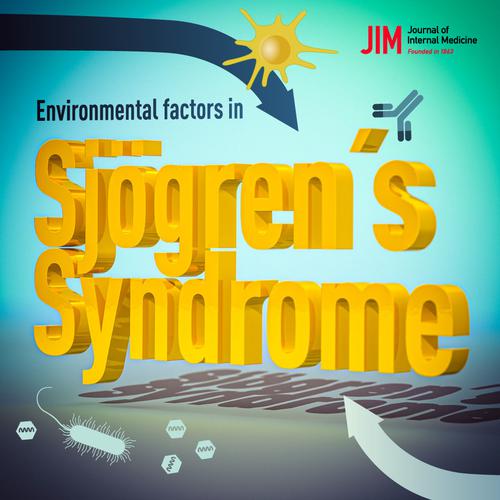当前位置:
X-MOL 学术
›
J. Intern. Med.
›
论文详情
Our official English website, www.x-mol.net, welcomes your
feedback! (Note: you will need to create a separate account there.)
Environmental factors in the pathogenesis of primary Sjögren's syndrome.
Journal of Internal Medicine ( IF 9.0 ) Pub Date : 2020-02-27 , DOI: 10.1111/joim.13032 A Björk 1 , J Mofors 1 , M Wahren-Herlenius 1
Journal of Internal Medicine ( IF 9.0 ) Pub Date : 2020-02-27 , DOI: 10.1111/joim.13032 A Björk 1 , J Mofors 1 , M Wahren-Herlenius 1
Affiliation

|
Primary Sjögren's syndrome (SS) is a systemic autoimmune disease in which exocrine organs, primarily the salivary and lacrimal glands, are targets of chronic inflammation, leading to severe dryness of eyes and mouth. Fatigue and arthralgia are also common, and extraglandular manifestations involving the respiratory, nervous and vascular systems occur in a subset of patients. Persistent activation of the type I interferon system, and autoreactive B and T cells with production of disease-associated autoantibodies are central to the pathogenesis. Genetic polymorphisms that associate with an increased risk of SS have been described, though the risk-increase contributed by the respective variant is generally low. It is thus becoming increasingly clear that genetics cannot alone account for the development of SS and that other, presumably exogenous, factors must play a critical role. Relatively few studies have investigated exposure to potential risk factors prior to SS disease onset. Rather, many factors have been studied in prevalent cases. In this review, we summarize current literature on exogenous factors in the pathogenesis of SS including infections, hormones, smoking, solvents and additional compounds. We delineate for which factors there is current evidence of increased disease risk, and for which our present knowledge is confined to suggesting their role in SS pathogenesis. Finally, we outline future perspectives in the continued search for environmental risk factors for SS, a research area of great importance considering the possibilities for preventive measures.
中文翻译:

原发性干燥综合征的发病机理中的环境因素。
原发性干燥综合征(SS)是一种全身性自身免疫性疾病,其中外分泌器官(主要是唾液和泪腺)是慢性炎症的目标,导致眼睛和口腔严重干燥。疲劳和关节痛也很常见,涉及呼吸,神经和血管系统的腺外表现发生在一部分患者中。I型干扰素系统的持续激活以及与疾病相关的自身抗体产生的自身反应性B和T细胞是发病机理的关键。已经描述了与SS风险增加相关的遗传多态性,尽管由相应变体引起的风险增加通常较低。因此,越来越清楚的是,遗传学不能单独说明SS的发展,而其他大概是外源的 因素必须发挥关键作用。相对较少的研究调查了SS病发作之前暴露于潜在危险因素的可能性。相反,在普遍情况下已经研究了许多因素。在这篇综述中,我们总结了有关SS发病机制中外源因素的最新文献,包括感染,激素,吸烟,溶剂和其他化合物。我们描述了哪些因素目前有增加疾病风险的证据,而我们目前的知识仅限于暗示它们在SS发病机理中的作用。最后,我们在继续寻找SS的环境危险因素时概述了未来的观点,这是一个非常重要的研究领域,考虑了预防措施的可能性。相对较少的研究调查了SS病发作之前暴露于潜在危险因素的可能性。相反,在普遍情况下已经研究了许多因素。在这篇综述中,我们总结了有关SS发病机制中外源因素的最新文献,包括感染,激素,吸烟,溶剂和其他化合物。我们描述了哪些因素目前有增加疾病风险的证据,而我们目前的知识仅限于暗示它们在SS发病机理中的作用。最后,我们在继续寻找SS的环境危险因素时概述了未来的观点,这是一个非常重要的研究领域,考虑了预防措施的可能性。相对较少的研究调查了SS病发作之前暴露于潜在危险因素的可能性。相反,在流行的情况下已经研究了许多因素。在这篇综述中,我们总结了有关SS发病机制中外源因素的最新文献,包括感染,激素,吸烟,溶剂和其他化合物。我们描述了哪些因素目前有增加疾病风险的证据,而我们目前的知识仅限于暗示它们在SS发病机理中的作用。最后,我们在继续寻找SS的环境危险因素时概述了未来的观点,这是一个非常重要的研究领域,考虑了预防措施的可能性。我们总结了有关SS发病机制中外源因素的最新文献,包括感染,激素,吸烟,溶剂和其他化合物。我们描述了哪些因素目前有增加疾病风险的证据,而我们目前的知识仅限于暗示它们在SS发病机理中的作用。最后,我们在继续寻找SS的环境危险因素时概述了未来的观点,这是一个非常重要的研究领域,考虑了预防措施的可能性。我们总结了有关SS发病机理中外源因素的最新文献,包括感染,激素,吸烟,溶剂和其他化合物。我们描述了哪些因素目前有增加疾病风险的证据,而我们目前的知识仅限于暗示它们在SS发病机理中的作用。最后,我们在继续寻找SS的环境危险因素时概述了未来的观点,这是一个非常重要的研究领域,考虑了预防措施的可能性。
更新日期:2020-02-27
中文翻译:

原发性干燥综合征的发病机理中的环境因素。
原发性干燥综合征(SS)是一种全身性自身免疫性疾病,其中外分泌器官(主要是唾液和泪腺)是慢性炎症的目标,导致眼睛和口腔严重干燥。疲劳和关节痛也很常见,涉及呼吸,神经和血管系统的腺外表现发生在一部分患者中。I型干扰素系统的持续激活以及与疾病相关的自身抗体产生的自身反应性B和T细胞是发病机理的关键。已经描述了与SS风险增加相关的遗传多态性,尽管由相应变体引起的风险增加通常较低。因此,越来越清楚的是,遗传学不能单独说明SS的发展,而其他大概是外源的 因素必须发挥关键作用。相对较少的研究调查了SS病发作之前暴露于潜在危险因素的可能性。相反,在普遍情况下已经研究了许多因素。在这篇综述中,我们总结了有关SS发病机制中外源因素的最新文献,包括感染,激素,吸烟,溶剂和其他化合物。我们描述了哪些因素目前有增加疾病风险的证据,而我们目前的知识仅限于暗示它们在SS发病机理中的作用。最后,我们在继续寻找SS的环境危险因素时概述了未来的观点,这是一个非常重要的研究领域,考虑了预防措施的可能性。相对较少的研究调查了SS病发作之前暴露于潜在危险因素的可能性。相反,在普遍情况下已经研究了许多因素。在这篇综述中,我们总结了有关SS发病机制中外源因素的最新文献,包括感染,激素,吸烟,溶剂和其他化合物。我们描述了哪些因素目前有增加疾病风险的证据,而我们目前的知识仅限于暗示它们在SS发病机理中的作用。最后,我们在继续寻找SS的环境危险因素时概述了未来的观点,这是一个非常重要的研究领域,考虑了预防措施的可能性。相对较少的研究调查了SS病发作之前暴露于潜在危险因素的可能性。相反,在流行的情况下已经研究了许多因素。在这篇综述中,我们总结了有关SS发病机制中外源因素的最新文献,包括感染,激素,吸烟,溶剂和其他化合物。我们描述了哪些因素目前有增加疾病风险的证据,而我们目前的知识仅限于暗示它们在SS发病机理中的作用。最后,我们在继续寻找SS的环境危险因素时概述了未来的观点,这是一个非常重要的研究领域,考虑了预防措施的可能性。我们总结了有关SS发病机制中外源因素的最新文献,包括感染,激素,吸烟,溶剂和其他化合物。我们描述了哪些因素目前有增加疾病风险的证据,而我们目前的知识仅限于暗示它们在SS发病机理中的作用。最后,我们在继续寻找SS的环境危险因素时概述了未来的观点,这是一个非常重要的研究领域,考虑了预防措施的可能性。我们总结了有关SS发病机理中外源因素的最新文献,包括感染,激素,吸烟,溶剂和其他化合物。我们描述了哪些因素目前有增加疾病风险的证据,而我们目前的知识仅限于暗示它们在SS发病机理中的作用。最后,我们在继续寻找SS的环境危险因素时概述了未来的观点,这是一个非常重要的研究领域,考虑了预防措施的可能性。











































 京公网安备 11010802027423号
京公网安备 11010802027423号